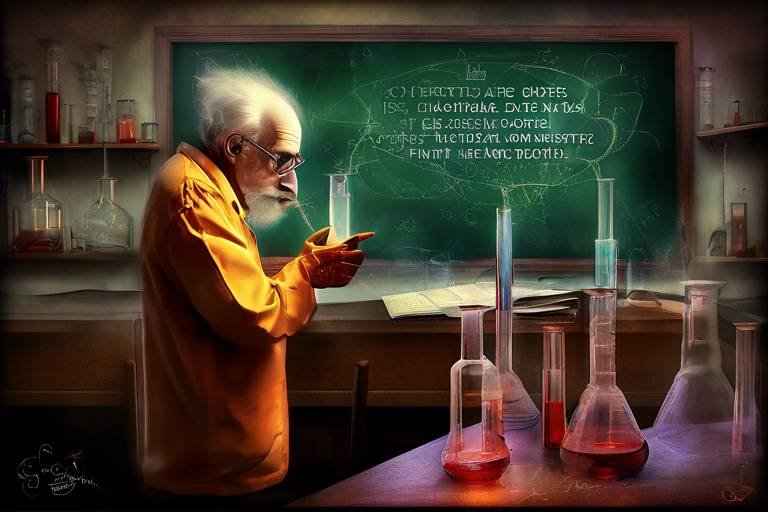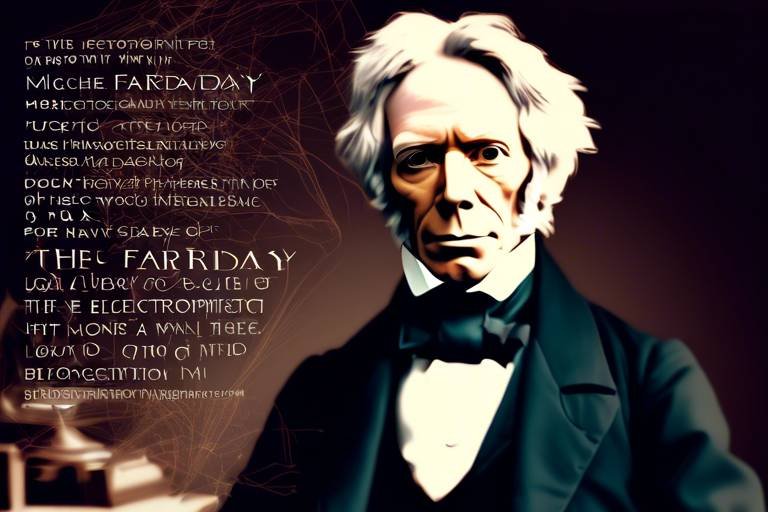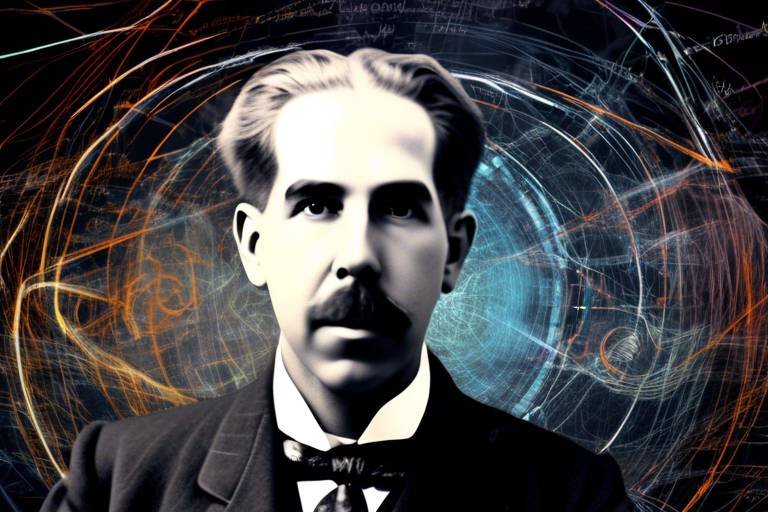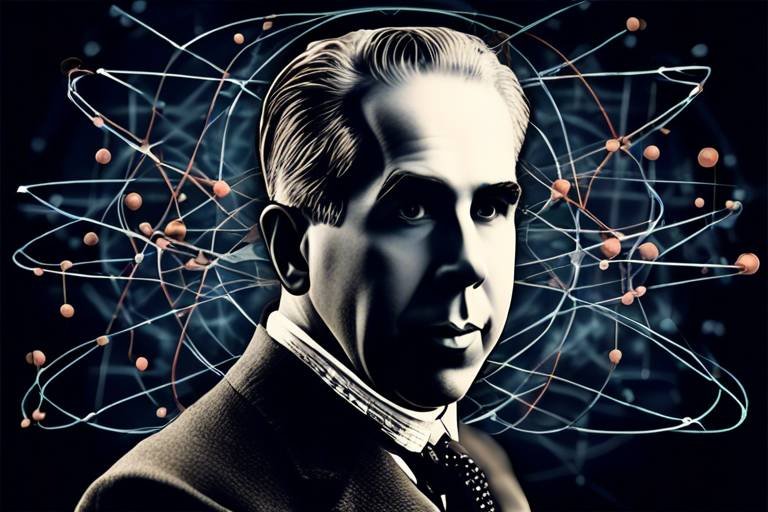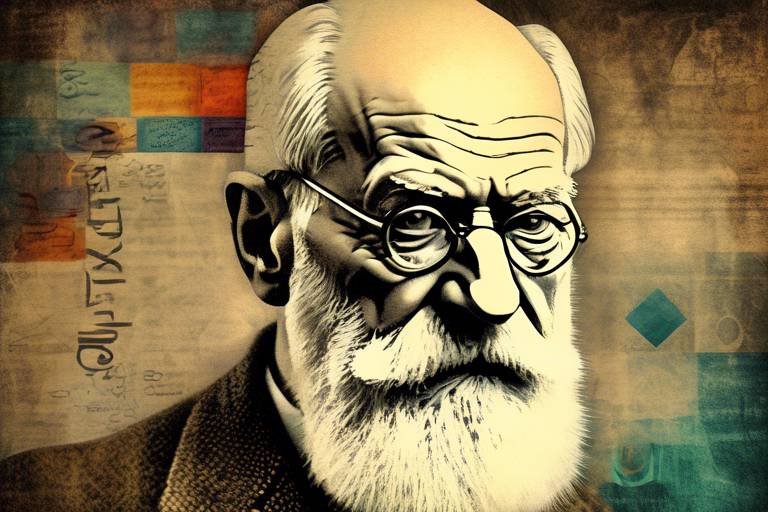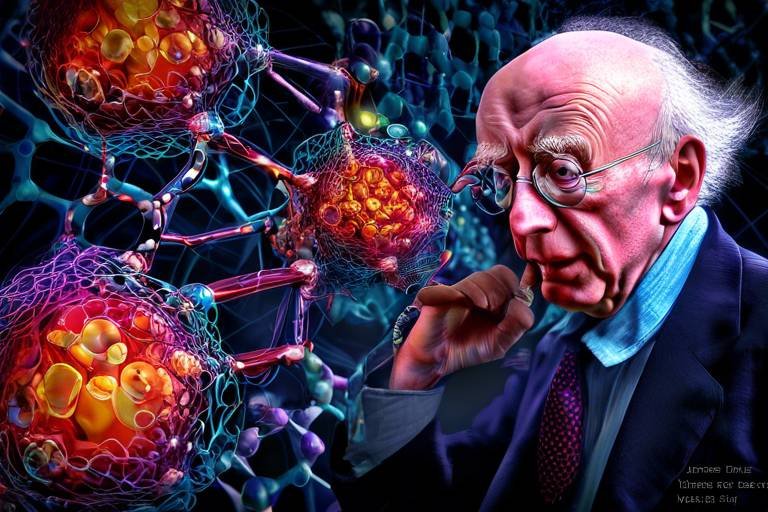The Work of Rosalind Franklin in DNA Research
Rosalind Franklin, a name that resonates in the annals of scientific history, made groundbreaking contributions to our understanding of DNA, the very blueprint of life. Her meticulous work and innovative techniques not only advanced the field of molecular biology but also laid the foundation for future discoveries in genetics. But who was Rosalind Franklin, and what exactly did she do that was so pivotal? In this article, we will dive deep into her life, her revolutionary methods, and the legacy she left behind that continues to inspire scientists to this day.
Born on July 25, 1920, in London, England, Rosalind Franklin's journey into the world of science began early on. Growing up in a family that valued education, she was encouraged to pursue her interests, which led her to excel in her studies. Franklin attended Newnham College, Cambridge, where she earned a degree in Natural Sciences. Her time at Cambridge was formative; she was influenced by prominent scientists of her time and developed a keen interest in physical chemistry. This combination of rigorous academic training and personal passion for science would become the bedrock of her future achievements.
One of Franklin's most significant contributions to DNA research was her development of innovative X-ray diffraction techniques. These methods allowed her to visualize molecular structures at an unprecedented level of detail. By directing X-rays at crystalline samples of DNA, she was able to produce images that revealed critical information about the molecule's structure. Her approach was meticulous and required a deep understanding of both physics and chemistry, showcasing her exceptional skill as a scientist.
Franklin's research provided vital insights into the helical structure of DNA. Through her X-ray diffraction images, she was able to deduce that DNA had a double helix configuration, a finding that was crucial for understanding how genetic information is stored and transmitted. Her work not only illuminated the physical structure of DNA but also had profound implications for genetic research and molecular biology. It was as if she had uncovered the secret code of life itself, offering a glimpse into the very essence of biological inheritance.
Among her many contributions, one image stands out: Photo 51. This iconic X-ray diffraction image of DNA, captured by Franklin in 1952, was pivotal in revealing the double helix structure. The clarity and detail of Photo 51 provided the evidence that scientists like Watson and Crick needed to formulate their famous model of DNA. However, it’s important to recognize that this groundbreaking image was the result of Franklin's hard work and expertise. It was a milestone in the history of molecular biology, showcasing the intricate beauty of the DNA molecule.
Franklin's scientific journey was not without its challenges. Her collaborations and rivalries with other scientists, particularly James Watson and Francis Crick, were complex and often fraught with tension. While Watson and Crick are often credited with the discovery of the DNA structure, it was Franklin's data that provided the crucial insights they needed. This dynamic raises important questions about collaboration in science and how often the contributions of women have been overlooked. Franklin's experience serves as a reminder that scientific progress is rarely a solitary endeavor, but rather a tapestry of shared knowledge and sometimes, fierce competition.
Despite her significant contributions, Franklin's work was often overshadowed, especially during her lifetime. It wasn't until after her death in 1958 that her contributions began to receive the recognition they deserved. Today, she is celebrated as a pioneer in molecular biology, and her legacy is honored in various ways. From awards to research institutes named in her honor, Franklin's impact on science continues to be felt. She has become a symbol of the importance of recognizing all contributors in scientific discoveries, regardless of gender.
Franklin's research has had a lasting impact on molecular biology and genetics. Her findings have paved the way for numerous advancements in the field, influencing areas such as genetic engineering, biotechnology, and even medicine. The techniques she developed are still in use today, showcasing the enduring relevance of her work. As we delve deeper into the genetic underpinnings of life, Franklin's insights remain a guiding light for researchers everywhere.
Franklin's pioneering work continues to inspire countless scientists today. Her methods and discoveries motivate new generations of researchers in the field of genetics. Many young scientists look to her as a role model, not just for her scientific achievements but also for her resilience in the face of adversity. Her story serves as a beacon of hope, encouraging future researchers to pursue their passions and challenge the status quo.
In recognition of her contributions, various honors and memorials have been established. These include:
- The Rosalind Franklin Award for Women in Science
- The Rosalind Franklin Institute in the UK
- Numerous biographies and documentaries celebrating her life and work
These accolades not only honor her memory but also serve to inspire future generations of scientists to follow in her footsteps.
Q: What was Rosalind Franklin's most significant contribution to DNA research?
A: Franklin's most significant contribution was her development of X-ray diffraction techniques, which led to the discovery of the double helix structure of DNA.
Q: Why was Photo 51 important?
A: Photo 51 was crucial because it provided the first clear evidence of the helical structure of DNA, which was essential for Watson and Crick's model of DNA.
Q: How has Rosalind Franklin's legacy been recognized?
A: Franklin's legacy has been recognized through various awards, memorials, and institutions named in her honor, as well as increased awareness of her contributions to science.

Early Life and Education
Born on July 25, 1920, in London, Rosalind Franklin grew up in a family that valued education and intellectual curiosity. Her father, a prominent banker, and her mother, a member of the social elite, instilled in her a love for learning from an early age. Franklin was a bright student, excelling in her studies and showing a particular interest in science and mathematics. This early passion laid the foundation for her future endeavors in the scientific community.
Franklin attended St. Paul's Girls' School, where she was encouraged to pursue her interests in science. It was here that she first encountered the wonders of chemistry and physics, which would later become the cornerstones of her groundbreaking research. After completing her schooling, she went on to study at Newnham College, Cambridge University, where she earned her degree in Natural Sciences in 1941. Her time at Cambridge was marked by intense study and a burgeoning interest in physical chemistry.
During her years at Cambridge, Franklin was not only a diligent student but also a trailblazer for women in science. At a time when female scientists faced significant barriers, she proved her capabilities through her academic achievements and determination. After graduating, she continued her education at the University of Paris, where she honed her skills in X-ray crystallography—a technique that would later become pivotal in her research on DNA.
Franklin's education was characterized by a blend of rigorous scientific training and an unyielding spirit. She was known for her meticulous attention to detail and her innovative approach to scientific problems. These qualities were crucial as she navigated the male-dominated field of science, where her contributions would eventually challenge the status quo.
In summary, Rosalind Franklin's early life and education were instrumental in shaping her as a pioneering scientist. Her academic journey not only equipped her with the necessary skills but also fueled her passion for discovery, setting the stage for her remarkable contributions to DNA research.

Franklin's X-ray Diffraction Technique
Rosalind Franklin's contributions to the field of molecular biology are nothing short of revolutionary, and at the heart of her groundbreaking work was her X-ray diffraction technique. This method, which she meticulously developed, allowed scientists to peer into the molecular world with unprecedented clarity. Imagine trying to decipher a complex puzzle without having all the pieces in front of you; that’s what studying molecular structures was like before Franklin’s innovations. Her technique not only provided a clearer picture of molecular arrangements but also opened new avenues for understanding biological processes at the atomic level.
Franklin's approach involved using high-quality X-ray crystallography to analyze the patterns produced when X-rays were directed at crystalline samples. This method was akin to shining a light on a hidden object, revealing details that were previously obscured. The resulting diffraction patterns were rich with information, enabling her to deduce the dimensions and shapes of molecules. In fact, her work with carbon compounds and viruses laid the groundwork for her later studies on DNA.
One of her most notable achievements was the creation of Photo 51, a striking X-ray diffraction image of DNA that would later become iconic. The clarity and detail of this photograph were unparalleled, and it revealed the helical structure of DNA with remarkable precision. To put it simply, Photo 51 was the Rosetta Stone for molecular biology—it translated the complex language of DNA into something comprehensible for scientists around the world.
Franklin's technique was not without its challenges, though. The process required meticulous preparation and a deep understanding of crystallography. She faced numerous obstacles, including the need for high-quality crystals and the intricacies of interpreting the resulting data. Yet, her determination and innovative spirit propelled her forward. She was relentless in her pursuit of accuracy, often spending long hours in the lab, perfecting her methods. This dedication to her craft is a testament to her character and her commitment to scientific inquiry.
To illustrate the key components of Franklin's X-ray diffraction technique, here’s a simple comparison of traditional methods versus her innovative approach:
| Aspect | Traditional Methods | Franklin's Technique |
|---|---|---|
| Image Quality | Often blurry and unclear | High-resolution and detailed |
| Sample Preparation | Less refined | Meticulously optimized |
| Data Interpretation | Limited insights | Rich in structural information |
In summary, Franklin's X-ray diffraction technique was a game-changer in the field of molecular biology. It not only provided crucial insights into the structure of DNA but also set a new standard for scientific research. Her ability to combine technical skill with innovative thinking allowed her to break through barriers that had previously stifled progress in understanding the building blocks of life. The legacy of her work continues to influence modern science, reminding us of the importance of perseverance and creativity in the pursuit of knowledge.
- What is X-ray diffraction? X-ray diffraction is a technique used to study the structure of crystalline materials by observing the patterns produced when X-rays are scattered by the electrons in the crystal.
- How did Franklin's work influence DNA research? Franklin's X-ray diffraction images provided critical evidence for the helical structure of DNA, which was essential for understanding genetic information and molecular biology.
- What challenges did Franklin face in her research? Franklin encountered difficulties in obtaining high-quality crystals and interpreting complex diffraction patterns, but her persistence and expertise led to significant breakthroughs.

Understanding DNA Structure
Rosalind Franklin's groundbreaking research significantly advanced our understanding of the DNA structure. Before her contributions, the mysteries of DNA were largely unsolved, and many scientists were grasping at straws. Franklin's meticulous work with X-ray diffraction provided a clear window into the molecular architecture of DNA, allowing scientists to visualize the double helix structure that is now iconic in the field of genetics.
One of the key insights from Franklin's studies was her identification of the helical nature of DNA. By analyzing the patterns produced by X-ray diffraction, she was able to deduce important characteristics of the DNA molecule, including its diameter and the spacing between the bases. This was not just a minor detail; it was akin to finding the blueprint of a complex building. Her data revealed that DNA was not just a random assortment of nucleotides but a highly organized structure that could replicate itself with precision.
In her research, Franklin discovered two forms of DNA: the wet form (B-DNA) and the dry form (A-DNA). The wet form, which is more prevalent in biological systems, features a right-handed spiral, while the dry form presents a different structural configuration. This distinction was crucial, as it highlighted how environmental conditions could influence the molecular structure of DNA. Understanding these forms allowed scientists to appreciate the dynamic nature of DNA, much like how a chameleon adapts its colors to its surroundings.
Franklin's most famous X-ray diffraction image, known as Photo 51, was pivotal in confirming the helical structure of DNA. The clarity and detail in this image provided the evidence that James Watson and Francis Crick needed to propose their double helix model. It was as if Franklin had handed them the missing piece of a complex jigsaw puzzle, enabling them to see the complete picture. This image not only showcased her technical skill but also underscored the importance of collaboration and communication in scientific research.
The implications of Franklin's work extend far beyond the structure of DNA itself. By elucidating the arrangement of nucleotides and the helical configuration, her research laid the groundwork for countless discoveries in molecular biology and genetics. Today, we understand that the structure of DNA is fundamental to processes such as replication, transcription, and translation. These processes are crucial for life, as they govern how genetic information is stored, expressed, and passed on to future generations.
In summary, Franklin's contributions to understanding DNA structure were not merely academic; they were revolutionary. Her work transformed the field of genetics, paving the way for modern biotechnology and genetic engineering. As we delve deeper into the complexities of DNA and its role in life, we owe a significant debt to Rosalind Franklin, whose insights continue to inspire and inform research today.
- What was Rosalind Franklin's primary contribution to DNA research?
Franklin's primary contribution was her development of X-ray diffraction techniques, which allowed her to visualize the helical structure of DNA, leading to the discovery of its double helix configuration.
- How did Photo 51 impact DNA research?
Photo 51 provided crucial evidence of DNA's double helix structure, which was instrumental for Watson and Crick in formulating their model of DNA.
- What are the two forms of DNA discovered by Franklin?
Franklin discovered the wet form (B-DNA) and dry form (A-DNA), each with distinct structural characteristics influenced by environmental conditions.

Photo 51: A Milestone Image
When we talk about groundbreaking moments in the history of science, one cannot overlook the significance of Photo 51. Captured by Rosalind Franklin in 1952, this iconic X-ray diffraction image of DNA was more than just a photograph; it was a window into the very essence of life itself. The image provided crucial evidence for the helical structure of DNA, a discovery that would later lead to the elucidation of the double helix model by Watson and Crick.
To put it simply, Photo 51 was the missing puzzle piece that scientists had been searching for. It showcased a distinctive pattern that hinted at the helical structure, which was a game-changer in molecular biology. The clarity of the image was a testament to Franklin's skill and her innovative X-ray diffraction techniques, which she meticulously developed during her research.
The importance of Photo 51 can be summarized in a few key points:
- Revealed Helical Structure: The cross-shaped pattern in the photo indicated that DNA was not just a random collection of molecules but had a specific, organized structure.
- Influenced Major Discoveries: The insights gained from this image were instrumental in the formulation of the Watson-Crick model of DNA, which ultimately led to a revolution in genetics.
- Legacy of Collaboration: While Franklin's work was pivotal, it also sparked a discussion about collaboration and recognition in the scientific community, as her contributions were often overshadowed by her male counterparts.
In essence, Photo 51 was not just a photograph; it was a milestone that marked the convergence of art and science, revealing the intricate dance of molecules that govern life. Its impact continues to be felt today as researchers build upon Franklin's legacy, delving deeper into the mysteries of genetics and molecular biology.
- What is Photo 51? Photo 51 is an X-ray diffraction image of DNA taken by Rosalind Franklin that revealed the helical structure of DNA.
- Why is Photo 51 important? It provided critical evidence that contributed to the understanding of DNA's structure, leading to the discovery of the double helix model.
- How did Rosalind Franklin's work influence modern science? Franklin's research techniques and findings laid the groundwork for significant advancements in genetics and molecular biology.
- Was Rosalind Franklin recognized for her contributions during her lifetime? Unfortunately, much of her work was overshadowed by her male counterparts, and she received limited recognition during her lifetime.

Collaboration and Competition
Rosalind Franklin's journey in the world of DNA research was not just marked by her groundbreaking discoveries; it was also characterized by a complex web of collaboration and competition. The scientific community, especially during the early 1950s, was a bustling arena where ideas clashed and converged. Franklin worked alongside some of the brightest minds in science, yet her relationships were often tinged with rivalry. One of the most notable interactions was with James Watson and Francis Crick, who were also racing to uncover the structure of DNA.
Franklin's meticulous approach to research and her innovative X-ray diffraction techniques set her apart from her contemporaries. While Watson and Crick were developing their model of DNA, they relied heavily on the data that Franklin had generated, particularly her famous Photo 51. This image was a game changer, providing critical insights into the helical structure of DNA. Yet, it was a classic case of collaboration through competition. Franklin was largely unaware that her work was being utilized by Watson and Crick, which led to a significant ethical debate in the scientific community.
In the world of science, competition can be fierce, and Franklin was no stranger to this reality. Her relationship with her colleagues at King's College London was often strained due to the intense pressure to publish and secure funding. While she collaborated with other scientists, her fierce independence sometimes created a sense of isolation. This tension is exemplified in her interactions with Maurice Wilkins, her colleague, who had a different approach to research and was often at odds with her.
Despite the competitive atmosphere, it is essential to recognize that Franklin's work was foundational. Her rigorous methods and dedication to accuracy pushed the boundaries of molecular biology. The interplay of collaboration and competition ultimately fueled advancements in the field, even if it came at a personal cost for Franklin. Many believe that had her contributions been more widely recognized during her lifetime, the narrative of DNA research would look quite different today.
In retrospect, the dynamics of collaboration and competition in Franklin's career highlight a critical aspect of scientific progress. It raises questions about how recognition is given in the scientific community and the importance of ethical practices in research. As we reflect on her legacy, it's clear that both collaboration and competition played a vital role in shaping the path of molecular biology.
- What was Rosalind Franklin's most significant contribution to DNA research?
Rosalind Franklin's most significant contribution was her development of X-ray diffraction techniques, which led to the discovery of the DNA double helix structure through her iconic Photo 51. - Did Rosalind Franklin receive recognition during her lifetime?
Unfortunately, Franklin did not receive the recognition she deserved during her lifetime. Her contributions were often overshadowed by her male counterparts, particularly Watson and Crick. - How did competition affect Rosalind Franklin's work?
Competition drove Franklin to produce high-quality research, but it also created a challenging environment that led to tensions with colleagues, particularly in her interactions with Watson and Crick. - What is the legacy of Rosalind Franklin today?
Today, Rosalind Franklin is celebrated as a pioneer in molecular biology. Her work continues to inspire new generations of scientists and emphasizes the importance of ethical practices in research.

Legacy and Recognition
Rosalind Franklin's legacy is a powerful reminder of the importance of recognition in science. Despite her groundbreaking contributions to the understanding of DNA, she remained largely unacknowledged during her lifetime. It wasn’t until after her death in 1958 that the scientific community began to fully appreciate the magnitude of her work. Franklin's meticulous research and innovative techniques laid the foundation for many discoveries in molecular biology, yet her name was often overshadowed by her male counterparts, particularly James Watson and Francis Crick, who famously received the Nobel Prize for their work on DNA structure, largely based on her findings.
In an ironic twist, Franklin's contributions were initially overlooked, leading to a complex narrative of gender bias in science. Many believe that her gender played a role in the lack of recognition she received, which highlights the challenges faced by women in scientific fields. However, as time passed, her work began to receive the acknowledgment it deserved. Today, she is celebrated not only for her scientific achievements but also as a symbol of female empowerment in science.
Several honors and memorials have been established to commemorate Franklin's legacy, including:
- The Rosalind Franklin Award, which recognizes exceptional contributions by women in science.
- The Rosalind Franklin Institute in the UK, dedicated to advancing life sciences through interdisciplinary research.
- Various educational initiatives and scholarships aimed at encouraging young women to pursue careers in science and technology.
Furthermore, her story has been told in books and documentaries, bringing her remarkable journey to light and inspiring future generations. The impact of her work is evident in modern genetics research, where her findings continue to inform studies on DNA structure and function. Franklin's legacy is not just about her scientific contributions; it’s also about the resilience and determination she showed in the face of adversity.
In recent years, there has been a concerted effort to rectify the historical oversight of Franklin's contributions. She is now frequently included in discussions about the history of DNA research, and her story serves as a vital lesson on the need for equity in scientific recognition. As we look to the future, it is essential to ensure that all scientists, regardless of gender, receive the credit they deserve for their discoveries and innovations.

Impact on Molecular Biology
Rosalind Franklin's contributions to the field of molecular biology are nothing short of revolutionary. Her meticulous research and innovative techniques laid the groundwork for a deeper understanding of DNA, which is often referred to as the blueprint of life. The implications of her work extend far beyond her time, influencing a myriad of scientific inquiries and advancements that continue to shape our understanding of genetics today.
One of the most significant impacts of Franklin's research is the clarity it brought to the structure of DNA. Before her groundbreaking work, the concept of DNA was largely theoretical and poorly understood. Franklin's X-ray diffraction images, particularly the iconic Photo 51, provided compelling evidence of the double helix structure. This discovery was pivotal, as it enabled scientists to grasp how genetic information is stored and transmitted across generations. The realization that DNA could carry genetic instructions in such a compact form was akin to discovering a hidden treasure map that detailed the intricacies of life itself.
Moreover, Franklin's techniques in X-ray crystallography have become foundational in molecular biology. Her ability to produce high-quality images of complex biological molecules has inspired countless researchers. Today, many scientists utilize similar methodologies in their studies, whether they are investigating proteins, viruses, or other nucleic acids. The ripple effect of her work can be seen in various fields, including:
- Genetic Engineering: Franklin's insights into DNA structure paved the way for techniques such as CRISPR, allowing for precise editing of genetic material.
- Medical Research: Understanding DNA has been crucial in developing treatments for genetic disorders and cancers.
- Biotechnology: Her work has influenced the development of biotechnology, from pharmaceuticals to agricultural advancements.
In addition to her direct contributions, Franklin's legacy inspires a culture of rigorous scientific inquiry. Her story serves as a reminder of the importance of perseverance and dedication in research, especially for women in science. By overcoming the challenges she faced in a male-dominated field, Franklin has become a beacon of hope and motivation for aspiring scientists. Her influence can be seen in the increasing representation of women in STEM (Science, Technology, Engineering, and Mathematics) fields, encouraging future generations to pursue their passions without hesitation.
As we delve deeper into the realms of molecular biology, the importance of Franklin's work becomes even more pronounced. The ongoing research into genetic diseases, the development of gene therapies, and the exploration of the human genome project all trace their roots back to the foundational knowledge that Franklin helped establish. It is as if she planted a seed that has now grown into a vast forest of scientific inquiry, with branches reaching into every corner of biology and medicine.
In summary, Rosalind Franklin's impact on molecular biology is profound and far-reaching. Her discoveries not only advanced our understanding of DNA but also set the stage for future innovations in genetics and beyond. As we continue to explore the mysteries of life at a molecular level, her legacy remains a guiding light, illuminating the path for scientists around the world.
- What was Rosalind Franklin's main contribution to DNA research?
Franklin's main contribution was her development of X-ray diffraction techniques, which provided critical insights into the double helix structure of DNA. - How did Franklin's work influence modern genetics?
Her findings laid the groundwork for genetic engineering, medical research, and various biotechnological advancements. - Why is Photo 51 significant?
Photo 51 was a key X-ray diffraction image that revealed the double helix structure of DNA, which was crucial for understanding genetic information storage. - What challenges did Franklin face in her career?
Franklin faced significant challenges, including gender bias and recognition issues in a predominantly male scientific community.

Influence on Future Researchers
Rosalind Franklin’s groundbreaking work in DNA research has left an indelible mark on the scientific community, inspiring countless future researchers. It’s fascinating to think about how one person's dedication and innovative spirit can ripple through time, influencing generations of scientists who strive to unlock the mysteries of life. Franklin's meticulous approach to her experiments and her pioneering X-ray diffraction techniques have become a blueprint for modern molecular biology.
Many researchers today cite Franklin as a pivotal figure in their decision to pursue careers in science. Her story is not just one of scientific achievement; it’s also a narrative of resilience and determination in the face of adversity. In a field that was predominantly male during her time, Franklin’s tenacity serves as a powerful reminder of the importance of diversity and inclusion in scientific research. By breaking barriers, she has opened doors for women and underrepresented groups in STEM fields, encouraging them to follow in her footsteps.
Franklin’s influence extends beyond her specific discoveries. Her commitment to rigorous scientific methodology has set a standard that many strive to emulate. For instance, her use of X-ray crystallography to elucidate the structure of complex molecules has been adopted by researchers in various fields, from pharmacology to materials science. This technique has become essential for understanding the intricate structures of proteins and nucleic acids, paving the way for advancements in drug development and genetic engineering.
Moreover, Franklin’s work has sparked interest in collaborative research efforts. The dynamic between collaboration and competition, as seen in her interactions with Watson and Crick, highlights the complex nature of scientific discovery. Today, many researchers advocate for interdisciplinary collaborations, recognizing that combining diverse expertise can lead to breakthroughs that would be impossible in isolation. Franklin’s legacy encourages scientists to share knowledge and work together, fostering an environment where innovation can thrive.
In educational institutions, Franklin’s contributions are increasingly recognized in curricula focused on the history of science. Students are taught not only about the scientific principles she uncovered but also about the ethical dimensions of research, including issues of credit and recognition. This emphasis on ethics is crucial, as it shapes the next generation of scientists to be not just skilled researchers but also responsible stewards of scientific integrity.
In summary, Rosalind Franklin's influence on future researchers is profound and multifaceted. Her legacy lives on through the methodologies she pioneered, the barriers she broke, and the inspiration she provides to aspiring scientists. As we continue to unravel the complexities of genetics and molecular biology, Franklin’s spirit of inquiry and dedication to scientific rigor will undoubtedly guide and inspire future generations.
- What techniques did Rosalind Franklin use in her DNA research?
Franklin used X-ray diffraction techniques, which allowed her to visualize the structure of DNA and other molecular compounds. Her most famous image, Photo 51, was crucial in understanding DNA's double helix structure.
- Why is Rosalind Franklin's work often overlooked?
Despite her significant contributions, Franklin's work was overshadowed by her male counterparts, particularly Watson and Crick, who received the Nobel Prize for the discovery of the DNA structure. It wasn’t until later that her vital role was recognized.
- How has Franklin's legacy influenced modern science?
Franklin's emphasis on rigorous scientific methodology and her pioneering techniques continue to inspire researchers today, encouraging collaboration and ethical standards in scientific research.

Honors and Memorials
Rosalind Franklin's contributions to science were monumental, yet her recognition during her lifetime was often eclipsed by her male counterparts. However, her legacy has been honored and celebrated in numerous ways since her passing. Today, her name is synonymous with groundbreaking research in molecular biology, and various institutions and organizations have established awards, scholarships, and memorials in her honor.
One of the most notable honors is the Rosalind Franklin Award, which is presented annually to women in science who have made significant contributions to their fields. This award not only celebrates Franklin's achievements but also aims to inspire future generations of female scientists. Additionally, many universities have created scholarships in her name, promoting the education of young women pursuing careers in the sciences.
Moreover, the Rosalind Franklin Institute was established in the UK to advance research in life sciences and to honor her legacy. This institute focuses on developing innovative technologies to understand biological processes, echoing Franklin's own pioneering spirit. The institute serves as a reminder of her impact on scientific inquiry and the importance of supporting women in STEM fields.
Franklin's life and work have also been commemorated through various memorial lectures and symposiums held worldwide, where scientists gather to discuss advancements in genetics and molecular biology. These events not only honor her memory but also encourage collaboration and the exchange of ideas among researchers.
In addition to institutional honors, Franklin's name has been immortalized in popular culture. She has been featured in numerous biographies, documentaries, and even plays, such as "Photograph 51," which dramatizes her life and the challenges she faced in a male-dominated field. Such portrayals help to raise awareness about her contributions and the importance of recognizing the work of women in science.
To sum it up, the honors and memorials dedicated to Rosalind Franklin are a testament to her enduring influence in the scientific community. They serve as powerful reminders of the need for diversity in science and the importance of recognizing the contributions of all scientists, regardless of gender. Her legacy continues to inspire new generations, ensuring that her work will never be forgotten.
- What is the Rosalind Franklin Award?
The Rosalind Franklin Award is given annually to women in science who have made significant contributions to their fields, honoring Franklin's legacy and encouraging future female scientists. - What is the Rosalind Franklin Institute?
The Rosalind Franklin Institute is a research institute in the UK dedicated to advancing life sciences and developing innovative technologies, inspired by Franklin's pioneering work. - How has Rosalind Franklin's work been portrayed in popular culture?
Franklin's life has been depicted in various biographies, documentaries, and plays, notably the play "Photograph 51," which highlights her challenges and contributions in science.
Frequently Asked Questions
- What were Rosalind Franklin's main contributions to DNA research?
Rosalind Franklin made significant contributions to DNA research, primarily through her development of X-ray diffraction techniques. Her most notable achievement was the production of Photo 51, an image that provided critical evidence for the double helix structure of DNA. This work laid the groundwork for understanding genetic material and molecular biology.
- How did Franklin's X-ray diffraction technique work?
Franklin's X-ray diffraction technique involved directing X-rays at a crystalized sample of DNA. The X-rays would scatter upon hitting the atoms in the DNA, creating a diffraction pattern. By analyzing these patterns, she was able to glean vital information about the molecular structure of DNA, including its helical shape.
- What is the significance of Photo 51?
Photo 51 is often considered a milestone in DNA research. Captured by Franklin, it revealed the helical structure of DNA, which was crucial for understanding how genetic information is stored and transmitted. This image played a pivotal role in the work of Watson and Crick, who later used it to formulate their famous double helix model.
- How did Franklin's collaborations and rivalries affect her work?
Franklin's collaborations and rivalries, particularly with James Watson and Francis Crick, were complex. While she shared valuable insights and data, her relationships were often characterized by competition. This dynamic propelled scientific progress but also led to a lack of recognition for her contributions during her lifetime.
- What is Rosalind Franklin's legacy in science?
Franklin's legacy is profound, as her pioneering research laid the foundation for modern genetics and molecular biology. Despite initially being overshadowed, her work has gained recognition over the years, inspiring future generations of scientists and highlighting the importance of women's contributions to science.
- How has Franklin's research influenced modern molecular biology?
Franklin's research has had a lasting impact on molecular biology by providing essential insights into DNA's structure and function. Her techniques continue to influence current research methodologies, and her findings have paved the way for advancements in genetic engineering, biotechnology, and medical research.
- What honors and memorials have been established in Franklin's name?
In recognition of her contributions, various honors and memorials have been established, including awards, scholarships, and scientific lectures named after her. These tributes serve to celebrate her legacy and promote the visibility of women in science, ensuring that her work continues to inspire future generations.


